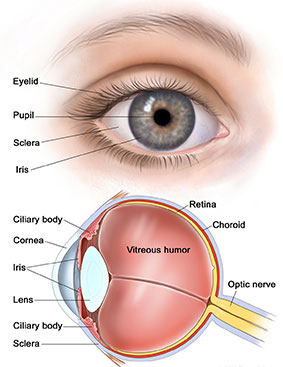Learn about causes, symptoms and treatment of Cataract. Learn about use of the latest state of the art technology for Cataract Surgery in Kharghar:
 What is the lens?
What is the lens?
The lens is a clear part of the eye that helps to focus light, or an image, on the retina. The retina is the light-sensitive tissue at the back of the eye. In a normal eye, light passes through the transparent lens to the retina. Once it reaches the retina, light is changed into nerve signals that are sent to the brain.
The lens must be clear for the retina to receive a sharp image. If the lens is cloudy from a cataract, the image you see will be blurred.
What is a cataract?
A cataract is a clouding of the lens in the eye that affects vision. Most cataracts are related to aging. Cataracts are very common in older people. By age 60, more than half of all Indians have a cataract which requires surgery. A cataract can occur in either or both eyes. It cannot spread from one eye to the other.
What causes cataracts?
The lens lies behind the iris and the pupil. It works much like a camera lens. It focuses light onto the retina at the back of the eye, where an image is recorded. The lens also adjusts the eye’s focus, letting us see things clearly both up close and far away. The lens is made of mostly water and protein. The protein is arranged in a precise way that keeps the lens clear and lets light pass through it.
But as we age, some of the protein may clump together and start to cloud a small area of the lens. This is a cataract. Over time, the cataract may grow larger and cloud more of the lens, making it harder to see.
Researchers suspect that there are several causes of cataract, such as smoking and diabetes. Or, it may be that the protein in the lens just changes from the wear and tear it takes over the years.
What are the symptoms of a cataract?
The most common symptoms of a cataract are:
- Cloudy or blurry vision.
- Colors seem faded.
- Glare. Headlights, lamps, or sunlight may appear too bright. A halo may appear around lights. This is more common with a particular type of cataract where the opacity is close to the posterior surface of the lens (posterior sub-capsular cataract).
- Poor night vision.
- Double vision or multiple images in one eye. (This symptom may clear as the cataract gets larger.)
- Frequent prescription changes in your eyeglasses or contact lenses.
- These symptoms also can be a sign of other eye problems. If you have any of these symptoms, check with your Eye Specialist.
How is a cataract detected?
Cataract is detected through a comprehensive eye exam by your Eye Specialist that includes:
- Visual acuity test. This eye chart test measures how well you see at various distances.
- Dilated eye exam. Drops are placed in your eyes to widen, or dilate, the pupils. Your Eye Specialist uses a special magnifying lens to examine your retina and optic nerve for signs of damage and other eye problems. After the exam, your close-up vision may remain blurred for several hours.
Your Eye Specialist also may do other tests to learn more about the structure and health of your eye.
You may also take the FREE interactive Cataract Self Test to find out if you have Cataracts.
Who is at risk for cataract?
The risk of cataract increases as you get older. Other risk factors for cataract include:
- Certain diseases such as diabetes.
- Personal behavior such as smoking and alcohol use.
- The environment such as prolonged exposure to sunlight.
How is a cataract treated?
The symptoms of early cataract may be improved with new eyeglasses or brighter lighting. If these measures do not help, surgery is the only effective treatment. Surgery involves removing the cloudy lens and replacing it with an artificial lens.
A cataract needs to be removed when vision loss interferes with your everyday activities, such as driving, reading, or watching TV. You and your Eye Specialist Doctor can make this decision together. Once you understand the benefits and risks of surgery, you can make an informed decision about whether cataract surgery is right for you. We do not have to wait for the cataract to ripen/mature to conduct the surgery.
What are the different types of cataract surgery?
There are two types of cataract surgery. Your doctor can explain the differences and help determine which is better for you:
- Phacoemulsification, or Phaco (Laser Eye Surgery). A small incision (<3mm) is made on the side of the cornea, the clear, dome-shaped surface that covers the front of the eye. Your doctor inserts a tiny probe into the eye. This device emits ultrasound waves that soften and break up the lens so that it can be removed by suction. Most cataract surgery today is done by phacoemulsification, also called “small incision cataract surgery.” At UTSAV EYE CLINIC, we use the latest state of the art Micro Incision Cataract surgery (MICS, Incision site 2.2mm) for performing most Cataract surgery in Kharghar.
- Extracapsular surgery. Your doctor makes a slightly longer incision on the side of the cornea and removes the cloudy core of the lens in one piece. The rest of the lens is removed by suction.
After the natural lens has been removed, it often is replaced by an artificial lens, called an intraocular lens (IOL). An IOL is a clear, plastic lens that requires no care and becomes a permanent part of your eye. Light is focused clearly by the IOL onto the retina, improving your vision. You will not feel or see the new lens.
What type of intraocular lenses (IOLs) are available?
At UTSAV EYE CLINIC, a variety of IOLs are available. The selection of IOL depends on the status of the cataract, patients needs, doctors recommendation and insurance packages. Details of these can be discussed with the Eye Specialist Doctor.
The two most common types of artificial lenses are monofocal and multifocal. Each lens has different features, which are described below.
Monofocal Artificial Lenses
A monofocal artificial lens provides one type of clear vision, either distance vision or near vision. People who get a monofocal lens during surgery choose which of these two options they want. Then they use glasses or contacts to help with the other type of vision.
For example, think of a woman who chooses a monofocal artificial lens that provides distance vision. She’ll need reading glasses to read or sew. If instead she picks the artificial lens that provides near vision, she’ll need glasses to drive or watch TV.
Multifocal Artificial Lenses
Multifocal artificial lenses provide both distance vision and near vision. They usually reduce how often people need to wear glasses after surgery. But most people who get this type of artificial lens still wear glasses some of the time.
People who get multifocal lenses may see less contrast than they could before the surgery. Also they tend to see more glare and halos around lights.
How do I decide which Intra Ocular lens (IOL) is best for me ?
You’ll need to think about how wearing glasses affects the different things you like to do. Would it be more convenient for you to be able to see things far away or close up without glasses ?
The following questions will help you understand your preferences:
- What activities in my life are important to me?
- How do I feel about wearing glasses for reading, writing, and other activities that require looking at things up close?
- How do I feel about needing glasses (or contacts) to drive, watch TV, or do other activities that require looking at things farther away?
Once you understand your preferences, talk to your Eye Specialist Doctor about which option will best meet your needs.
For More information on Cataract surgery, please do not hesitate to contact our Eye Specialist Doctor at Utsav Eye Clinic, Kharghar, Navi Mumbai.




Pingback: Five most common Cataract Surgery Myths - Utsav Eye Clinic